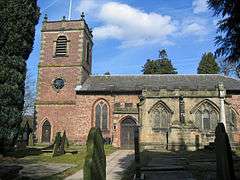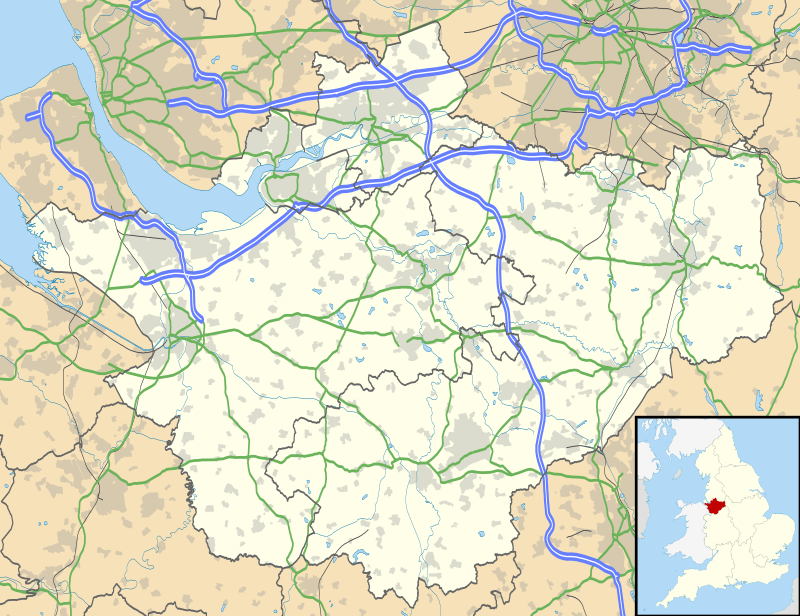St Lawrence's Church, Over Peover
St Lawrence's Church, Over Peover is in an isolated position approached by a lane in the civil parish of Peover Superior. The only other buildings nearby are Peover Hall and a farm. It lies some 3 miles (5 km) south of the town of Knutsford. The church is recorded in the National Heritage List for England as a designated Grade I listed building.[1] The church is an active Anglican parish church in the diocese of Chester, the archdeaconry of Macclesfield and the deanery of Knutsford. Its benefice is combined with that of St Oswald, Lower or Nether Peover.[2] It is noted for its old chapels and for the monuments to the Mainwaring family.
| St Lawrence's Church, Over Peover | |
|---|---|
 St Lawrence's Church, Over Peover, from the south | |
 St Lawrence's Church, Over Peover Location in Cheshire | |
| OS grid reference | SJ 772 736 |
| Location | Over Peover, Cheshire |
| Country | England |
| Denomination | Anglican |
| Website | St Lawrence, Over Peover |
| History | |
| Status | Parish church |
| Dedication | St Lawrence |
| Architecture | |
| Functional status | Active |
| Heritage designation | Grade I |
| Designated | 5 March 1959 |
| Architect(s) | J. Garlive, William Turner |
| Architectural type | Church |
| Style | Gothic, Neoclassical, Gothic Revival |
| Completed | 1811 |
| Specifications | |
| Materials | Brick tower and body Stone chapels with leaded roofs |
| Administration | |
| Parish | Over Peover |
| Deanery | Knutsford |
| Archdeaconry | Macclesfield |
| Diocese | Chester |
| Province | York |
History
It is thought that the original church was built in the reign of Edward III.[3] The present tower was built of brick in 1739, probably by J. Garlive. The nave and chancel were rebuilt in brick in 1811 by William Turner. During the restoration the pre-existing stone chapels were preserved. The south chapel dates from 1456 and the north chapel from 1648.[1] The north chapel was built by Ellen, widow of Philip Mainwaring.[3] The church was refurbished in 1895 by the Lancaster architects, Austin and Paley.[4] During the Second World War, General George Patton and his staff worshipped in the church while they were stationed in Peover Hall.[3]
Architecture
Exterior
The plan consists of a west tower, a four-bay undivided nave and chancel, south and north chapels, a south porch and a north vestry. The tower is in three stages. It has round windows and arched bell-windows with pilasters. The south chapel has two bays with three buttresses surmounted by gargoyles and a battlemented parapet. The north chapel is one of the earliest regular classical buildings in the region.[1]
Interior
The south chapel is approached through a porch and contains a canopied tomb with the effigies of Randle Mainwaring in a complete suit of plate armour, his feet resting on a lion and his head on the family crest, and his wife Margery in a long robe and an ornate head-dress. The Franciscan altar cross, brass candlesticks and hanging lamps are from Florence. The north chapel contains the marble effigies of Philip Mainwaring in plate armour, his feet resting on a lion and his head on the family crest, and Ellen with a bear at her feet. In this chapel are monuments to other members of the Mainwaring family.[3] The ceiling contains a carved coat of arms in its centre. The north chapel screen is by F. W. Crossley.[5] In both chapels are fragments of medieval stained glass.[6]
In the chancel are effigies of further members of the Mainwaring which date from the 15th century. These possibly represent John, son of Randle, and his second wife Joan. In the main body of the church is the 15th-century font which is set on a base dating from a later period. An altar dating from the 17th century has been moved to the south chapel. The pulpit is Jacobean. On the north wall of the church is a painting of The Boy Daniel by John Rogers Herbert (1810–1890). In commemoration for the use of the church in the Second World War by General Patton and his staff, an American flag has been placed in the church with an explanatory bronze plaque.[3] The organ was built in 1898 by Jardine.[7] There is a ring of three bells, dated around 1500, 1626 and 1669.[8] The churchwardens' accounts commence in 1674.[3]
External features
In the churchyard is an old cross base bearing a more modern cross. The cross base dates from the 15th century and consists of three steps rising to square plinth carrying an octagonal shaft base. The cross is dated 1907 and consists of an octagonal shaft topped by a gabled canopy over a cross and two figures of saints. It is listed at Grade II,[9] and is a scheduled monument.[10] Also in the churchyard is a sundial which was constructed in the 19th century using part of the shaft of the original 15th-century cross. The shaft stands on two square steps. It is also listed at Grade II.[11] In addition the churchyard contains the war graves of three soldiers of World War I, and an airman of World War II.[12]
See also
References
- Historic England, "Church of St Lawrence, Peover Superior (1139274)", National Heritage List for England, retrieved 14 May 2012
- Over Peover, St Lawrence, Church of England, retrieved 13 October 2009
- Richards, Raymond (1947), Old Cheshire Churches, London: Batsford, pp. 267–273, OCLC 719918
- Brandwood, Geoff; Austin, Tim; Hughes, John; Price, James (2012), The Architecture of Sharpe, Paley and Austin, Swindon: English Heritage, p. 241, ISBN 978-1-84802-049-8
- Hartwell, Clare; Hyde, Matthew; Hubbard, Edward; Pevsner, Nikolaus (2011) [1971], Cheshire, The Buildings of England, New Haven and London: Yale University Press, pp. 518–519, ISBN 978-0-300-17043-6
- Over Peover, St Lawrence, Corpus Vitrearum Medii Aevi, retrieved 2 January 2011
- "NPOR J00054", National Pipe Organ Register, British Institute of Organ Studies, retrieved 29 June 2020
- Peover Superior St Lawrence, Dove's Guide for Church Bell Ringers, retrieved 11 August 2008
- Historic England, "Cross base and cross in churchyard of Church of St Lawrence, Peover Superior (1139275)", National Heritage List for England, retrieved 14 May 2012
- Historic England, "Cross in the churchyard of Church of St Lawrence, Peover Superior (1018027)", National Heritage List for England, retrieved 14 May 2012
- Historic England, "Sundial in churchyard of Church of St Lawrence, Peover Superior (1329814)", National Heritage List for England, retrieved 14 May 2012
- OVER PEOVER (ST. LAWRENCE) CHURCHYARD, Commonwealth War Graves Commission, retrieved 3 February 2013
External links
| Wikimedia Commons has media related to St Lawrence's Church, Over Peover. |